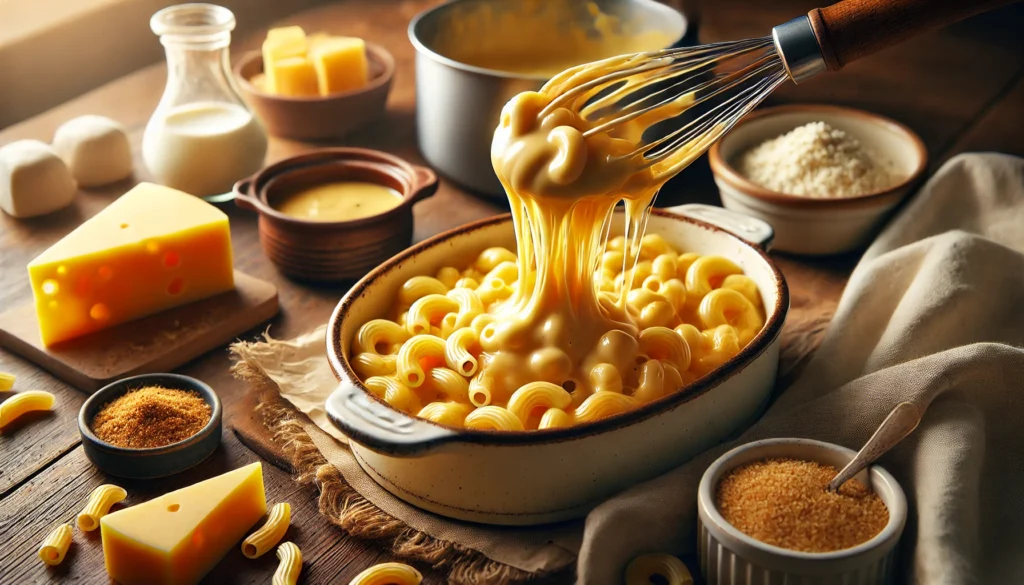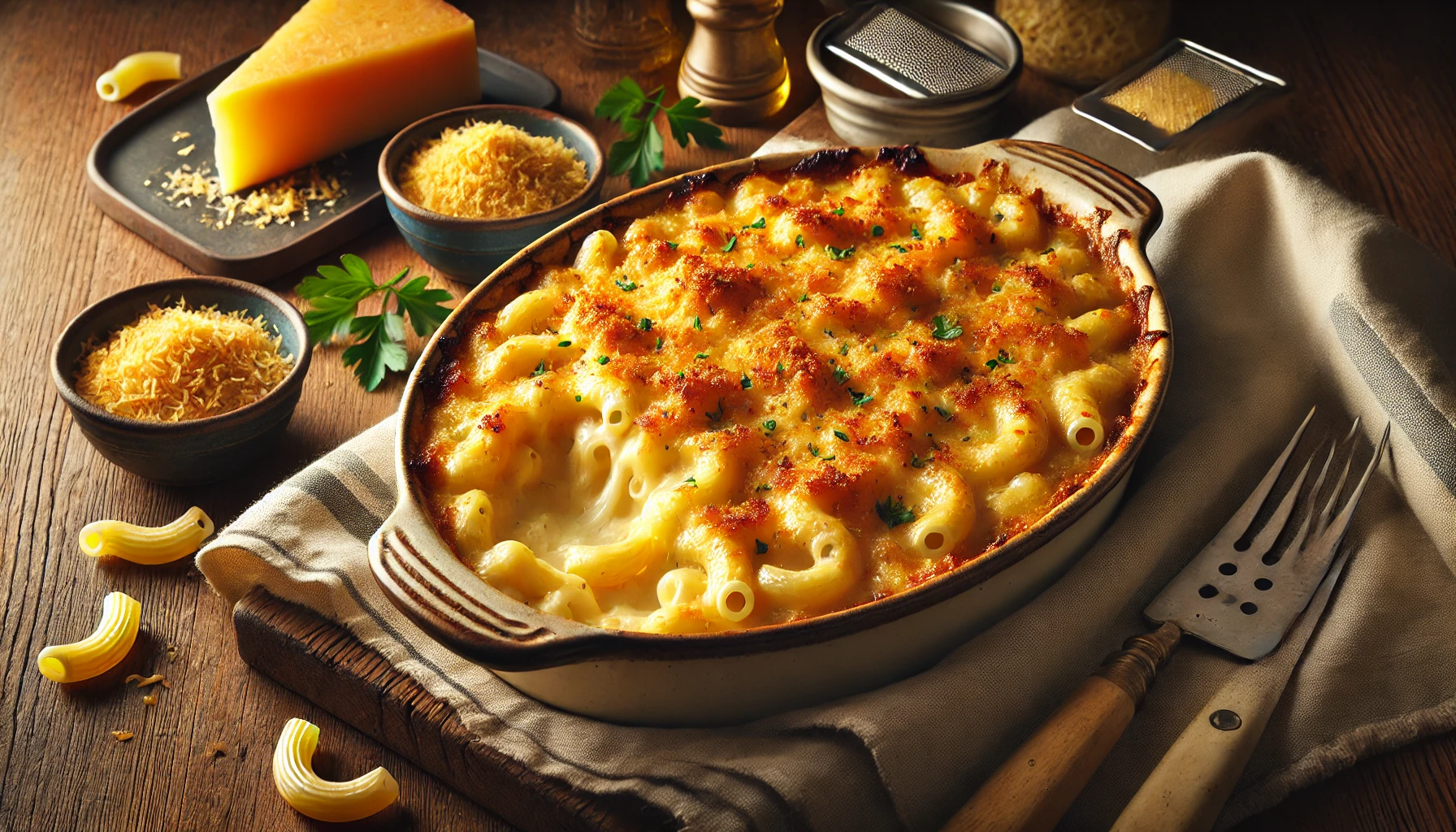Introduction
Macaroni and cheese is more than just a dish—it’s a warm, cheesy hug that brings comfort and joy. In this article, we’ll explore everything you need to know about making creamy macaroni and cheese that’s rich, gooey, and satisfying. From selecting the right ingredients to mastering the cooking techniques, we’ll guide you through every step to create a mouthwatering dish. You’ll also discover creative variations, expert tips, and answers to common questions about this timeless classic. Let’s dive in and uncover the secrets to making the perfect creamy macaroni and cheese!
Introduction to Creamy Macaroni and Cheese
What Makes Macaroni and Cheese a Comfort Food
Macaroni and cheese is a universal comfort food beloved by people of all ages. Its creamy texture and rich flavor evoke feelings of nostalgia and warmth, reminding us of home-cooked meals and cozy gatherings. The combination of gooey cheese and tender pasta creates a dish that feels indulgent yet simple. It’s perfect for a weeknight dinner, a holiday side dish, or even as a midnight snack. Its versatility and ability to adapt to various tastes make it a household staple.
The Evolution of Macaroni and Cheese Recipes
Macaroni and cheese has a fascinating history that spans centuries. Originally an Italian creation, it gained popularity in America during the colonial era. Early versions were made with simple pasta and cheese, but over time, recipes evolved to include a variety of cheeses, spices, and even toppings. Today, the dish has countless variations—from stovetop versions to baked casseroles with crispy, golden toppings. Whether you prefer a classic approach or enjoy experimenting with gourmet twists, macaroni and cheese remains a beloved dish that never goes out of style.
Essential Ingredients for Creamy Macaroni and Cheese
Choosing the Right Pasta Why Elbow Pasta Works Best
When learning how to make creamy macaroni and cheese, the first step is picking the right pasta. Elbow macaroni is a classic choice for a reason—it has the perfect shape to hold onto the creamy sauce. Its ridged surface and hollow center trap every bit of cheesy goodness, ensuring every bite is packed with flavor. Moreover, elbow pasta cooks quickly, making it convenient for both beginners and seasoned cooks. If you want to experiment, other pasta types like cavatappi or shell pasta can work well, but nothing beats the traditional elbow macaroni for that comforting, homemade touch.
The Secret to a Perfect Cheese Blend Types and Combinations
The cheese blend is the heart of creamy macaroni and cheese. A combination of sharp cheddar and Gruyère offers a rich, tangy flavor with a silky texture. Cheddar melts beautifully, while Gruyère adds a touch of nutty sweetness. For those who like experimenting, you can incorporate mozzarella for stretchiness or smoked gouda for a hint of smokiness. To ensure a smooth, lump-free sauce, always shred your cheese fresh from the block. Pre-shredded cheeses contain anti-caking agents that can affect how well the cheese melts, so taking this extra step can make all the difference.
Dairy Essentials Milk Cream and Their Roles in Creaminess
To achieve that signature creaminess, using the right dairy products is key. A mix of whole milk and heavy cream provides the perfect balance of richness and smoothness. Whole milk helps keep the sauce light, while heavy cream adds a luxurious texture. For an extra indulgent twist, some recipes use half-and-half, which combines the best of both worlds. Always bring your dairy to room temperature before adding it to the roux—this prevents curdling and ensures a silky, velvety sauce that clings to every strand of pasta.
Step-by-Step Preparation

Boiling the Pasta Achieving the Perfect Al Dente Texture
The foundation of how to make creamy macaroni and cheese lies in perfectly cooked pasta. Boil your elbow macaroni in generously salted water, but be careful not to overcook it. Aim for a firm al dente texture since the pasta will continue to cook when baked with the cheese sauce. Typically, this means cooking the pasta for about 1–2 minutes less than the package instructions suggest. Once drained, toss the pasta with a bit of olive oil to prevent sticking while you prepare the sauce.
Making the Roux Butter Flour and Thickening Magic
The secret to a thick, creamy cheese sauce starts with a roux. A roux is a simple mixture of melted butter and flour cooked together to form a paste. Melt unsalted butter in a saucepan over medium heat, then whisk in all-purpose flour until it resembles wet sand. Cooking the roux for a minute or two eliminates the raw flour taste and ensures your sauce will have a rich, smooth consistency. It’s the base that transforms your dairy into a luscious, velvety cheese sauce.
Creating the Cheese Sauce Combining and Melting the Cheeses
Once the roux is ready, gradually whisk in warm milk and cream, stirring constantly to avoid lumps. As the mixture thickens, reduce the heat and start adding your shredded cheeses in small batches. Stir gently until the cheese is fully melted and the sauce is silky smooth. Be patient—rushing this step can cause the cheese to clump. Adding a pinch of paprika or ground mustard can elevate the flavor, giving your sauce a subtle yet delightful kick.
Assembling the Dish Layering Pasta and Cheese
Now comes the fun part—assembling your creamy macaroni and cheese. Start by pouring half of the cooked pasta into a greased baking dish. Ladle a generous amount of cheese sauce over the pasta, ensuring every piece is coated. Add a layer of shredded cheese for extra gooeyness, then repeat with the remaining pasta and sauce. Finish with another layer of cheese on top for that golden, bubbly crust. Whether you’re baking the dish or serving it stovetop, this assembly guarantees a rich, creamy texture in every bite.
Baking Tips for the Ultimate Creamy Mac and Cheese
Preheating and Preparing Your Baking Dish
To achieve the perfect creamy macaroni and cheese, the baking process plays a crucial role. Start by preheating your oven to 350°F. A steady temperature ensures even cooking and prevents the sauce from drying out. Lightly grease a 9×13-inch baking dish to keep the pasta from sticking and to help create that golden, bubbly crust we all love. For added flavor, some cooks line their dish with a thin layer of melted butter before adding the pasta.
Optimal Baking Time and Temperature
Getting the baking time just right is essential to maintaining a creamy texture. Bake your macaroni and cheese for about 25–30 minutes, or until the top is lightly golden and the cheese is bubbling. Be careful not to overbake, as this can cause the sauce to dry out and the pasta to lose its tenderness. For a crispier topping, switch the oven to broil for the final 2–3 minutes. Watch closely to avoid burning the cheese topping.
Achieving a Golden Crispy Topping
A crispy, golden topping adds a delightful contrast to the creamy layers beneath. Sprinkle shredded cheese generously on top before baking to create a bubbly crust. For an extra crunch, mix panko breadcrumbs with melted butter and scatter them over the cheese layer. Crushed Ritz crackers are another excellent option for a buttery, crumbly texture.
For more delicious comfort food ideas, check out this guide on cooking hash browns at home.
Variations and Customizations
Adding Protein Bacon Chicken or Lobster
Elevate your creamy macaroni and cheese by adding protein-rich ingredients. Crispy bacon bits add a smoky, salty crunch, while shredded chicken lends heartiness to the dish. For a luxurious twist, stir in chunks of lobster for a rich, seafood flavor. These variations make your mac and cheese not just a side dish, but a satisfying main course that stands on its own.
Vegetarian Options Spinach Broccoli and Mushrooms
Vegetables can bring vibrant color and added nutrition to your macaroni and cheese. Fold in sautéed spinach for a pop of green and a mild, earthy flavor. Steamed broccoli florets add crunch and pair perfectly with cheesy sauces. For a more savory profile, try caramelized mushrooms, which add depth and a slightly meaty texture.
Stovetop vs Baked Macaroni and Cheese
Deciding between stovetop and baked mac and cheese comes down to personal preference. Stovetop versions are quick and deliver an ultra-creamy texture, perfect for those who love their mac and cheese silky and smooth. Baked versions, on the other hand, offer a satisfying blend of creamy layers and a golden, crispy topping. If you’re short on time, opt for the stovetop; when serving guests or for special occasions, baked mac and cheese makes a stunning presentation.
Making Mac and Cheese Ahead of Time
Prepping and Storing Unbaked Macaroni
If you’re wondering how to make creamy macaroni and cheese ahead of time, it’s simpler than you might think. Prepare the macaroni and cheese as usual, but stop before baking it. Transfer the assembled dish into a greased baking dish, then allow it to cool completely. Once cooled, cover the dish tightly with aluminum foil or plastic wrap to prevent moisture loss and refrigerate it for up to two days. This method allows you to save time while still serving a fresh, delicious dish when you’re ready.
Reheating for Maximum Creaminess
When reheating pre-made macaroni and cheese, the key is to preserve its creamy texture. Before baking, let the dish sit at room temperature for 30 minutes to ensure even heating. Bake it in a preheated oven at 350°F for 25–35 minutes, or until it’s hot and bubbly. To refresh the sauce, stir in a few tablespoons of milk or cream before baking. This helps restore the creamy consistency and prevents the pasta from drying out.
FAQs
What Cheeses Work Best for Macaroni and Cheese
The secret to the best macaroni and cheese lies in the choice of cheese. Sharp cheddar is a classic favorite due to its bold flavor and smooth melting properties. Gruyère adds a nutty, slightly sweet touch, while mozzarella provides a stretchy texture. For a smoky twist, try smoked gouda or provolone. Mixing different cheeses ensures a complex, rich flavor that takes your dish to the next level.
Can You Make Mac and Cheese Without Baking
Absolutely! If you prefer a quicker method, stovetop macaroni and cheese is the way to go. Cook the pasta, prepare the cheese sauce, and mix them together in a pot over medium heat. This technique skips the baking step but still delivers the creamy, cheesy comfort you’re craving. Plus, it’s a great option for busy weeknights or when you’re short on time.
How to Prevent Macaroni from Becoming Mushy
Avoiding mushy pasta is essential when learning how to make creamy macaroni and cheese. The trick is to cook the pasta al dente, which means it should still have a slight bite. Follow the package instructions but reduce the cooking time by 1–2 minutes. Remember, the pasta will continue to cook when combined with the cheese sauce and baked, so undercooking it slightly ensures the perfect texture.
What’s the Best Way to Reheat Leftovers
Reheating leftover macaroni and cheese can be tricky, but it’s doable without sacrificing its creaminess. The best method is to add a splash of milk or cream to the pasta, then heat it gently in a saucepan over low heat. Stir frequently to ensure the sauce doesn’t separate. Alternatively, you can microwave it in short intervals, stirring between each to keep the cheese sauce smooth and velvety. For a crisp topping, reheat leftovers in the oven at 350°F for 10–15 minutes.
Conclusion
Why Macaroni and Cheese is a Timeless Classic
There’s something magical about a dish that can be both nostalgic and endlessly versatile. Macaroni and cheese has earned its place as a timeless classic, offering comfort and satisfaction with every creamy, cheesy bite. It’s a dish that appeals to people of all ages, from kids enjoying a simple meal to adults indulging in gourmet versions. By learning how to make creamy macaroni and cheese, you not only master a classic recipe but also create opportunities to make cherished food memories for years to come.
Encouragement to Experiment and Personalize
One of the best things about macaroni and cheese is its adaptability. Whether you prefer a stovetop version for quick meals or a baked dish with a golden crust for special occasions, there’s a version for everyone. Don’t be afraid to experiment with different cheeses, mix-ins, or toppings to create your unique take on this classic comfort food. Remember, cooking is all about making a recipe your own. So, grab your ingredients, follow the steps, and enjoy the satisfaction of crafting the perfect creamy macaroni and cheese.
For More Delicious Recipes
For more comfort food ideas and recipes, check out this guide on preparing a classic Philly cheesesteak sandwich. It’s another hearty, flavorful dish that’s sure to please!

